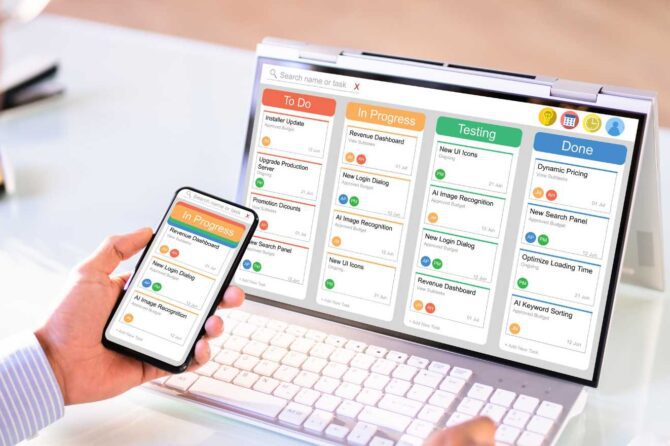Table of Contents
Introduction to Freelance Portfolio
A freelance portfolio is an essential tool for any freelancer looking to attract new clients and showcase their skills. Your portfolio is often the first impression potential clients will have of your work, so it’s important to make it as compelling as possible.
A strong freelance portfolio highlights your best work, illustrates the skills and services you offer, and shows who you are as a professional. It acts as a resume of sorts, allowing you to visually demonstrate your abilities rather than just describing them. This gives potential clients confidence in your skills and makes you stand out from other freelancers.
Having a polished online freelance portfolio is especially important in today’s digital world. Clients can easily view your portfolio anytime, anywhere, so you want to make sure it looks professional and presents you in the best light. A portfolio helps establish credibility and allows you to share examples that prospects can examine at their convenience.
Crafting a portfolio requires thoughtfulness and strategy. You want to carefully curate selections that convey your talents, experience, and work style. This guide will provide tips and best practices for creating a winning freelance portfolio that wows potential clients.
Determine Your Goals
Your freelance portfolio should be tailored to your target audience and goals. Before creating your freelance portfolio, take some time to think about who you want to reach and what you want to achieve.
Who is your target audience/client?
- Potential clients looking to hire freelancers for projects
- Businesses seeking a consultant or service provider
- Recruiters evaluating candidates for full-time positions
- Colleagues in your industry that you want to network with
Determine who you most want to impress and appeal to with your portfolio. This could be a specific type of client, industry, or role you are targeting. Align your freelance portfolio content and design to resonate with your ideal audience.
What do you want to achieve with your freelance portfolio?
- Get hired for freelance gigs
- Showcase your work to attract new clients
- Demonstrate your skills and experience
- Establish credibility and build trust
- Network and make connections in your industry
- Land a full-time job or promotion
- Grow your business and services
Be clear about your goals for your portfolio. This will inform what projects, skills, and details you emphasize. A portfolio to get freelance work may differ from one for a full-time job search. Define your purpose upfront to create the most effective freelance portfolio.
Highlight Your Best Work
Your portfolio should highlight your top 3-5 projects or case studies that demonstrate your skills and experience. Curate a diverse selection of your best work to showcase the range of your abilities.

For each project or case study, explain the purpose and goals, your specific contributions, and the results achieved. Use data, metrics, testimonials, or before-and-after comparisons to demonstrate the impact of your work.
When selecting projects, aim for diversity across:
- Industries – Include work in different sectors to show versatility.
- Services – Demonstrate a range of skills like design, writing, programming, etc.
- Roles – Showcase work where you played different roles like project manager, designer, developer, etc.
- Complexity – Have some simple and some complex projects to convey your capabilities.
- Results – Feature work that achieved outstanding outcomes for clients.
Choose projects you’re proud of and passionate about. Write detailed descriptions to provide context and help visitors understand your skills based on real work examples.
Showcase Your Skills
Your freelance portfolio is your chance to demonstrate the full range of your skills, abilities, and expertise. Don’t be shy – this is your time to shine! When showcasing your skills, it’s important to back up claims with concrete examples and proof points.
For instance, if you claim to be an expert in Adobe Creative Suite, back this up by including pieces created using Photoshop, Illustrator, InDesign, etc. If you consider yourself highly skilled in HTML/CSS, incorporate custom code samples. The more you can demonstrate these abilities directly within your freelance portfolio, the better.
Some additional tips for showcasing skills:
- Feature pieces that highlight your mastery of key software, tools, and technologies in your field. The more niche your skills, the better.
- Include examples of well-known techniques or industry standards that you have experience with. For designers, this may include isometric graphics or flat design. Developers could showcase knowledge of REST APIs, SASS, or React.
- Talk through specialized techniques, methodologies, or competencies you have. Explain your process and thinking. Images and videos can help reveal more about your skills.
- Weave in soft skills like communication, time management, and creativity. These are just as critical as hard skills for many clients and employers.
- If you take online courses, highlight key learnings and projects from these. Add certificates to your freelance portfolio as well.
The goal is to provide as much evidence as possible to back up any claims about your skills and experience. The more you can show rather than tell, the better. This establishes trust and confidence in your abilities.
Tell Your Story
Creating an About Me page is crucial for freelancers to share their stories and build trust with potential clients. This page acts as your online resume and helps showcase what makes you unique.

When crafting your About Me page:
- Write a short bio highlighting your background, skills, experience, education, and interests. Share details on what motivates you and what you’re passionate about.
- List the services you offer, the industries you specialize in, and the type of projects you work on. This helps clients understand what you do.
- Share your work philosophy, approach, and values. Communicate how you operate and what clients can expect when working with you.
- Include any awards, testimonials, publications, or press features that showcase your expertise. Social proof builds credibility.
- Add a professional headshot to form a personal connection. It helps put a face to your brand.
- Use an authentic, approachable tone. Avoid overly formal language and express your personality.
- Make sure to keep your About Me page updated as you gain more experience and accomplishments.
Your About Me page is a chance to share your story on your own terms. Take the time to thoughtfully craft it to appeal to your ideal clients and land more work.
Make it Visually Appealing
Your portfolio should have an attractive, professional design that showcases your skills and makes a great first impression. Visual elements like photos, videos, and infographics can help bring your work to life in an engaging way.
When formatting your freelance portfolio, consider using:
- A clean, uncluttered layout that draws attention to your work samples
- Plenty of white space and appropriate use of color to enhance readability
- High-quality images and videos that represent your skills
- Infographics, charts, or illustrations to visualize data creatively
- A cohesive style and branding that aligns with your professional identity
The visual presentation of your portfolio can communicate just as much about your abilities as the work examples themselves. An eye-catching yet elegant design demonstrates your creative flair and attention to detail.
Aim for a look and feel that is consistent with the type of work you want to be hired for. A developer’s portfolio may feature a sleek, modern aesthetic while a graphic designer’s uses bold, artistic styling.
No matter your field, a visually polished freelance portfolio shows you have the skills to produce professional-level work and the drive to go above and beyond. Invest time in perfecting the look, feel, and user experience to make a stellar first impression.
Optimize for Mobile
With the majority of web traffic now coming from mobile devices, it’s essential to optimize your freelance portfolio for mobile viewing. Follow these tips:
- Use a simple, intuitive navigation menu that converts to a “hamburger” menu on mobile. This allows easy access to all portfolio sections.
- Ensure your portfolio theme or template is fully responsive. Content should be reformatted for optimal viewing on any screen size. Images and text should resize, and columns should stack vertically on narrow screens.
- Check font sizes are legible on mobile. Heading and body text may need slight resizing to aid readability.
- Avoid large file sizes for images that are slow to load on mobile data. Compress and optimize images, or serve lower-resolution versions to mobile users.
- Use minimal scrolling. Mobile users should be able to access key sections and info without excessive scrolling.
- Include clickable phone and email links to encourage contact.
- Test extensively on mobile devices to identify any issues. Your freelance portfolio should work seamlessly on both desktop and mobile.
By optimizing for mobile, you ensure your portfolio can be easily viewed by the majority of users on their preferred devices. This helps make a great first impression and allows your work to shine, whatever the screen size.
Include Contact Info
Having your contact information prominently displayed in your freelance portfolio is essential so potential clients can get in touch. At the very least, you’ll want to include:
- Email – Your professional email address should be easy to find. Avoid using silly or unprofessional emails for your portfolio.
- Phone number – Even in our digital world, some people like to call to discuss projects. List your phone number so clients can call you if needed.
- Social media links – Links to your professional social media profiles allow clients to check out your work and brand. Popular platforms to include are LinkedIn, Twitter, Instagram, and Behance.
- Contact form – Include an online contact form on your site to make it easy for potential clients to reach out. The form should collect their name, email, project details, and message. Make sure to set up notifications so you see when new submissions come in.
Having multiple contact options in your portfolio gives clients flexibility in starting a conversation with you. Promptly returning messages and calls for new inquiries will help make a great first impression.
Promote Your Portfolio
Driving traffic to your online freelance portfolio through marketing and networking is key to getting it in front of potential clients and employers. Here are some tips for promoting your portfolio:
- Leverage social media. Share your freelance portfolio on platforms like LinkedIn, Twitter, Facebook, and Instagram. Post samples of your work, announce when you’ve added new projects, and link to your portfolio in your bio.
- Network online and in-person. Tell friends, family, colleagues, and new connections about your portfolio. Word-of-mouth referrals can be very powerful. Attend industry events and conferences to meet potential clients face-to-face.
- Create a portfolio website. If you don’t already have one, set up a professional website dedicated to your portfolio. This gives you a centralized place to direct people. Make sure the URL is easy to remember.
- List your site on directories. Sign up for freelance job boards and portfolio sites. This gets your work in front of people actively looking to hire.
- Hand out business cards. Business cards with your portfolio URL on them are an easy way to give contacts a way to view your work.
- Showcase your work publicly. Apply to showcase your portfolio at local art shows, creative events, and industry exhibitions.
- Collaborate with others. Partner with other freelancers to cross-promote each other’s services and portfolios.
- Write guest posts. Reach out to industry blogs and publications and offer to write posts related to your work. Include a link to your portfolio.
- Optimize with SEO. Use keywords and optimized meta descriptions so your portfolio is findable in search engines.
- Advertise if needed. Consider taking out ads on industry websites, job boards or social media. A small ad budget can further boost your visibility.
Maintain and Update
Your freelance portfolio is a living document that should be reviewed and refreshed regularly as your skills, experience, and work samples evolve. Set a reminder to revisit your portfolio every few months.
When reviewing, ask yourself the following questions:
- Does my portfolio accurately showcase my current skills and experience? Are there new projects or accomplishments I should add?
- Do my work samples still represent my best work and abilities? Should I swap in any recent projects that better demonstrate my skills?
- Is my portfolio still visually appealing and optimized for user experience? Does the layout or design need refreshing?
- Are all links, contact info, and other details still correct and up-to-date? Have I changed contact methods or relocated?
- What feedback have I received about my portfolio? Are there any areas identified for improvement that I should address?
- Are there new services I now offer that need to be reflected? Have I expanded into any additional niche specialties?
- Does my content and messaging still align with my personal brand and the image I want to project as a freelancer?
Keeping your portfolio updated is key for presenting an accurate picture of your capabilities to potential clients and opportunities. Be sure to implement any necessary changes promptly when reviewing. A portfolio that is current, comprehensive, and reflective of your skills will maximize your chances of winning new projects and contracts.




